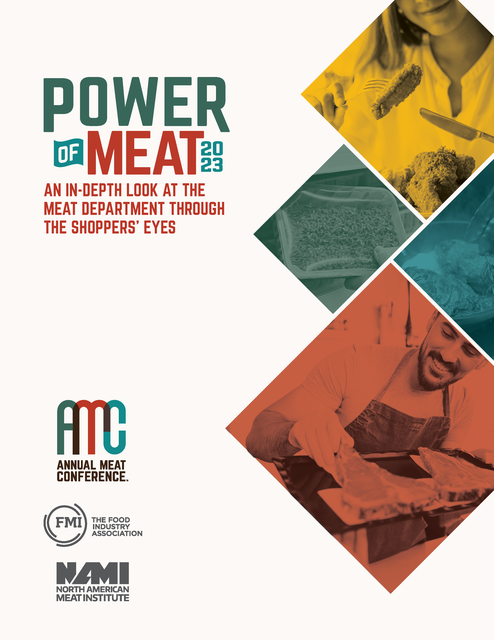Consumers spend over $15 in the meat department per trip and average nearly one trip to the meat department per week, up nearly 5 percent since 2019, according to the 18th annual Power of Meat report released Monday by the Meat Institute and The Food Industry Association.
Shoppers purchase meats from a variety of channels: 50 percent from a supermarket, 35 percent from supercenters, 4 percent from club stores, and 5 percent from hard discounters.
Americans are buying more fresh meat than before the COVID pandemic and are seeking value in terms of price, convenience, and better-for-you attributes. The report found that the sales volume of meat purchased in 2022 was 2.5 percent less than in 2021.
To save money, 76 percent report they made changes to the amount, type, cut, and/or brand of meat they purchased or changed where they shop. Consumers’ cost-saving strategies also include: buying only the amount needed, looking for coupons, and stocking up when meat is on sale. Seventeen percent said they buy less meat with organic, grass-fed, or other claims.
“The research tells us that we’re seeing a more price-conscious shopper, but we’re also witnessing shoppers seeking ‘simple pleasures’ and that’s one area among others where the meat department can delight,” said Rick Stein, VP of fresh foods for FMI, in a statement. “For example, shoppers concerned about food prices might opt to splurge on an at-home date-night meal. Food retailers can best serve today’s shoppers by emphasizing value-added meat options and catering to shoppers with meal solutions.”
The report also found that Americans prepare between four and five dinners at home during a typical week, 87 percent of which contain a portion of meat or poultry. With 55 percent of Americans using semi- or fully-prepared foods in their dinner preparation (compared to 45 percent who cook from scratch), purchases of pre-marinated, pre-cut, or pre-seasoned meat have increased dramatically.
“Meat continues to meet the needs of American families, across a wide range of priorities and preferences,” said Julie Anna Potts, president and CEO of the Meat Institute, in a statement. “Shoppers count on meat for quality, taste, convenience, and value, and the meat sector is taking action through the Protein PACT to ensure they can feel confident about doing so for generations to come.”
The Protein Pact brings together farmers, packers, and processors to protect consumers, animals, and the environment.
Related: Consumers Shift to More Affordable Produce; Impossible Foods Launches Chicken Products

